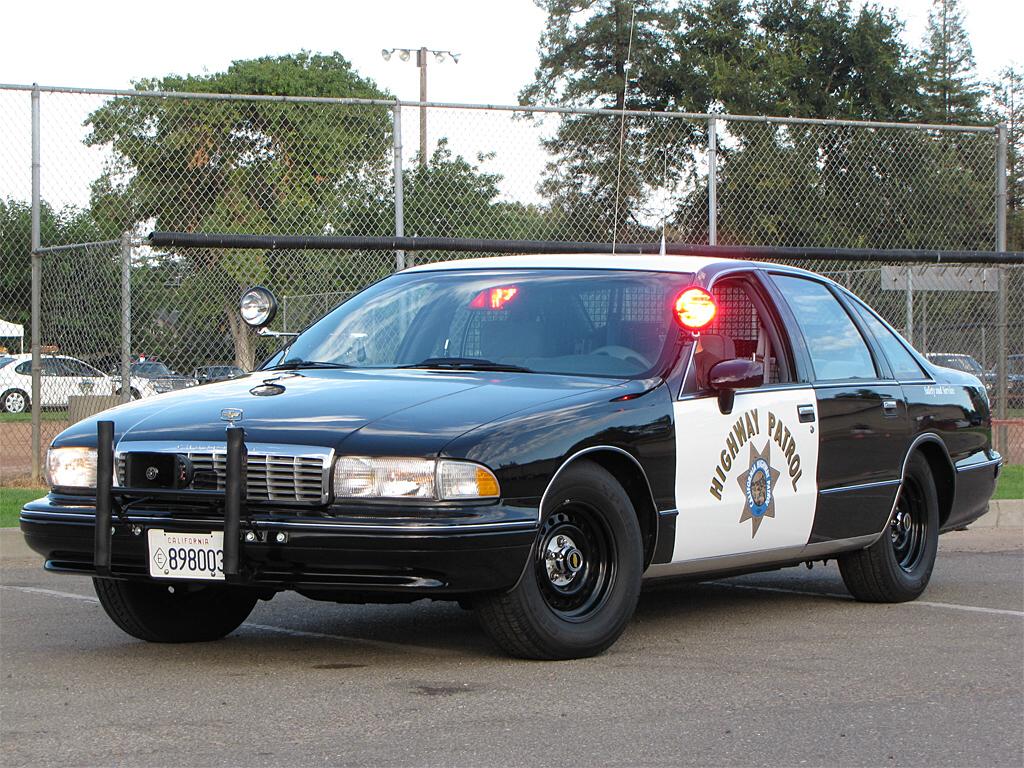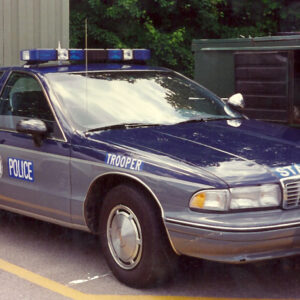The Chevy Caprice was redesigned for the 1991 model year and was introduced in the fall of 1990. It replaced the 1977-based rectilinear design with rounded, more aerodynamic sheetmetal. While the body and interior were all new, the chassis and powertrain were largely carried over from the 1977 and 1990 models respectively; the steel fuel tank was replaced by an HDPE tank (with capacity on sedans decreasing from 25 US gallons to 23 US gallons), and anti-lock brakes were added as standard equipment on all models. Several major components (including the floor pan) are entirely interchangeable between 1977 and 1996.
V6s were again available in 1992 and 1993, VIN code for the V6 is Z, option code is LB4. The LTZ was introduced in 1991 and was available in the US thru 1993, in the Middle East thru 1996. The 5.0L L03 and 5.7L L05 (190 horsepower) were also offered.
The new 9C1 Caprice featured a digital instrument cluster. The 1991-1993 9C1 and LTZ share the same digital cluster. 1991 was the best selling year for the 1991, 1992 ranks third (after 1994).
1991 was the BEST selling year of the last generation Caprice by any standards. The car sold WELL over GM’s original target figure. Motor Trend even made it Car of the Year in 1991. The “beached whale / didn’t sell well” narrative is what’s commonly found in mid-nineties publications and has been repeated endlessly well into this millennium – but it just doesn’t hold up in hindsight. What the Caprice failed to do was measure up against the Ford Taurus, which it was never intended to do, which again certain contemporary journalists at the time didn’t seem to fully understand. For 1993 there were some revisions, the most obvious being the removal of the unpopular skirted rear wheel wells in favor of more conventional, open wheel wells. Fleet Sales made up slightly less than 15% of the total sedan sales in 1991.
A final appearance tweak facelift appeared on the 1995 Caprice sedan in the form of a restyled side window between the back door and C pillar (windows on Caprices of the generation through 1994 were triangular, but the 1995 window had a so-called “Hofmeister kink”, featuring four sides and sweeping towards the front, lacking the sharp corner pointed toward the rear).
In 1994 the Caprice received new engines, including a LT1 350 cu in (5.7 L) engine built for performance that put out 260 horsepower and 330 lb·ft of torque on 87 octane. The Caprice LT1 is NOT a mildly detuned version of the Corvette LT1. Both engines share the same basic layout, but blocks, heads, camshafts, EVERYTHING is different between the two.
The standard engine in all sedans, including 9C1 police cars, was the 200 horsepower, L99 265 (4.3 L) V8 for better fuel economy in response to rising fuel prices after the Persian Gulf War. The LT1 was optional in the 9C1 police package and standard in all wagons. The LT1 350 was standard in civilian sedans with the addition of the V92 towing package. The V92 towing package also gave a heavy-duty suspension with similar spring rates to the 9C1 police car suspension, 2.93 gears, V08 heavy-duty cooling with a mechanical fan, heavy-duty rear drum brakes, and limited-slip differential.
The 1994-1996 Caprice 9C1 with the LT1 engine became one of the quickest and most popular modern-day police vehicles. This vehicle established such strong devotion by many police departments that a cottage industry thrived in refurbishing Caprices for continued police service after GM discontinued production of the car, with many police departments keeping them in service car longer than other police cars from that era.
The car’s production was stopped in December of 1996 due to sales pressure from the mid-size Chevrolet Lumina, financial troubles at General Motors, and consumer demand shifting from full-sized family sedans to the increasingly popular sport utility vehicles. The Arlington, Texas vehicle assembly plant (where the Caprice was built) was converted to produce GM’s more profitable full size Tahoe and Suburban.
Drivetrain:
1991 Chevy Caprice 350/5.7L
- Horsepower: 195
- Axle Ratio: 3.42
- Transmission: 4-Speed Automatic
1991-1993 Chevy Caprice 305/5.7L
- Horsepower: 170
- Axle Ratio: 2.56
- Transmission: 4-speed Automatic
1992-1993 Chevy Caprice 350/5.7L
- Horsepower: 205
- Axle Ratio: 3.42
- Transmission: 4-Speed Automatic
1994-1996 Chevy Caprice 305/5.7L
- Horsepower: 260
- Axle Ratio: 3.08
- Transmission: 4-speed Automatic
1994-1996 Chevy Caprice 265/4.3L
- Horsepower: 200
- Axle Ratio: 3.23
- Transmission: 4-speed Automatic
Michigan State Police Performance Tests:
| Vehicle | Engine | 1/4 Mile (Sec) | 0-100 MPH (Sec) | Top Speed |
| 1991 Chevy Caprice | 350/5.7 | 17.5 | 29.24 | 130 |
| 1991 Chevy Caprice | 305/5.0 | 19.0 | 41.84 | 124 |
| 1992 Chevy Caprice | 350/5.7 | 16.89 | 25.87 | 133 |
| 1992 Chevy Caprice | 305/5.0 | 18.44 | 36.40 | 128 |
| 1993 Chevy Caprice | 350/5.7 | 16.75 | 25.86 | 132 |
| 1993 Chevy Caprice | 305/5.0 | 18.70 | 41.56 | 121 |
| 1994 Chevy Caprice | 350/5.7 | 16.18 | 21.64 | 141 |
| 1994 Chevy Caprice | 265/4.3 | 18.11 | 30.18 | 122 |
| 1995 Chevy Caprice | 350.5.7 | 16.29 | 22.43 | 135 |
| 1995 Chevy Caprice | 265/4.3 | 18.31 | 33.12 | 120 |
| 1996 Chevy Caprice | 350/5.7 | 16.14 | 21.47 | 139 |
| 1996 Chevy Caprice | 265/4.3 | 18.05 | 32.00 | 120 |
Photo Gallery:
Click the photos to enlarge.
About The Author
Code 3 Garage
I started my career as a police officer in 1989 with the Geneva on The Lake Police Department. I worked part time as a police officer and full time as a Security Sergeant doing armed mobile security patrols for a local security company. In 1990 I became a State Trooper with the Ohio State Highway Patrol. During my career as a State Trooper I was certified as a Technical Crash Investigator, OPOTA Police Instructor, OPOTA Police Driving Instructor, LASER Instructor, and received awards for ACE (Auto Larceny) and Post Trooper of The Year. Code 3 Garage is a mix of my inner automotive gearhead, and public safety background. I hope you enjoy it!






























